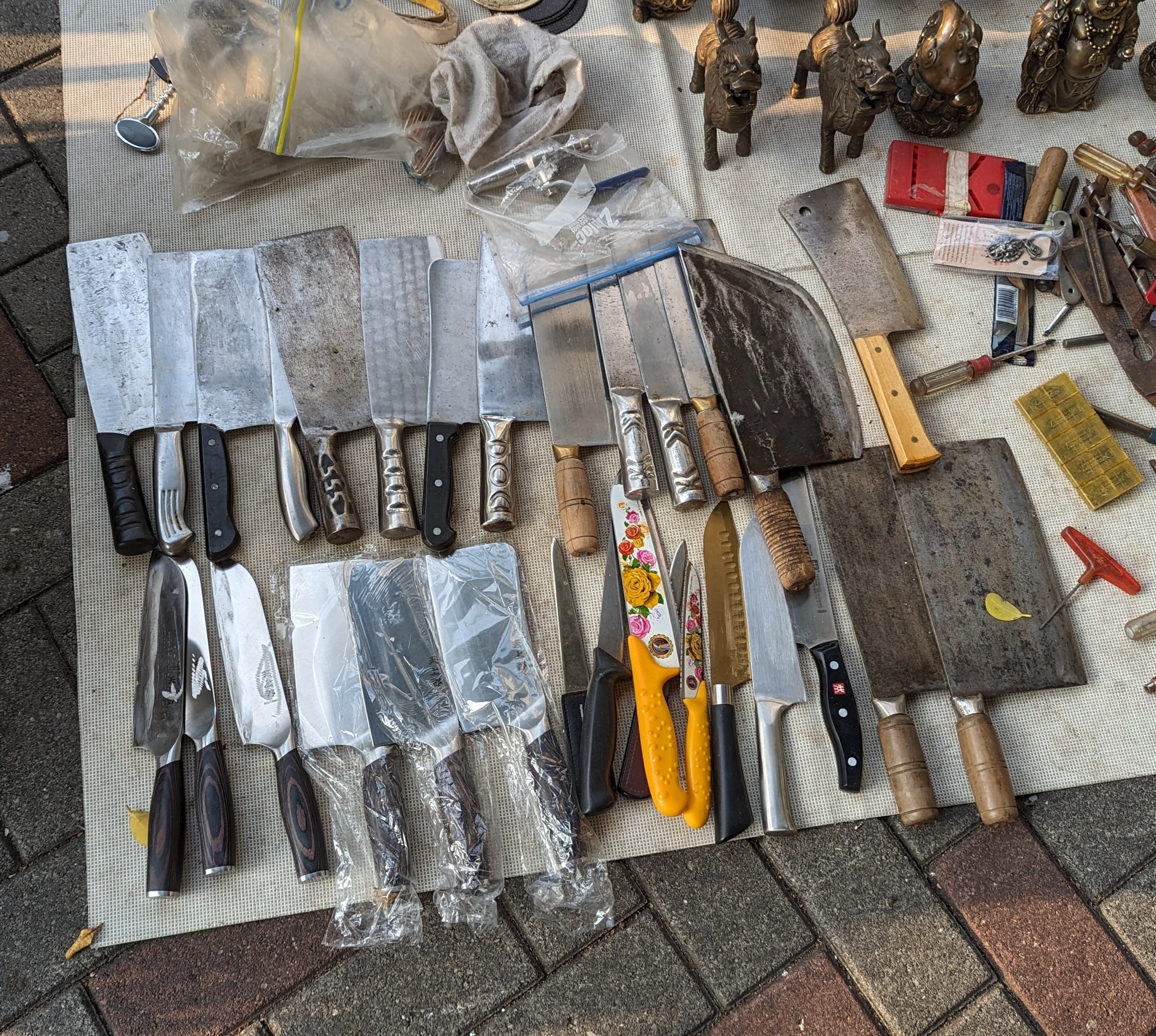You may see other articles refer to Chinese chef’s knives - 菜刀 (pronounced caidao/choidou in Mandarin and Cantonese respectively) - as Chinese cleavers. Here at Fragrant Knives, we feel that the association of the word ‘cleaver’ with meat cleavers in English leads to a misunderstanding of what the knife is truly for. Others translate more literally: the characters taken individually mean ‘vegetable knife’, but the concept is a little more tricky. This kind of knife is by no means used only for vegetables, but is rather an all-purpose knife in the kitchen, slicing meat and filleting fish just as much as chopping carrots or greens. The word 菜 too, is a little more broad than the English ‘vegetable’, as it can also refer to cooked dishes eaten with rice - even when the dish doesn’t include vegetables at all.
Some writers prefer the word ‘chopper’ as a better translation than cleaver. We prefer it too - except that to us, ‘chopper’ also suggests that the knife’s primary function is chopping, rather than just being one of many different functions.
Speaking to the global influence of Chinese cuisine and migration is the word Chūka Bōchō (中華包丁). This is the Japanese word for Chinese chef’s knife, usually referring to a Chinese-style chef’s knife redesigned and made by a Japanese bladesmith using Japanese forging techniques. Just as ramen is a heavily adapted version of Chinese lamian, brought over by Chinese migrants to Japan in the early 20th century, Chūka Bōchō is an adapted version of the knives those migrant chefs brought with them.
In recognition of all this, we choose to translate 菜刀 (caidao/choidou) as ‘Chinese chef’s knife’, a mouthful for sure, but a little more accurate in describing the all-purpose nature of the tool. Needless to say, ‘Chinese’ here refers to the broadest possible definition of Chinese food culture: these Chinese chef’s knives are used anywhere Chinese food is cooked, not exclusively in China or Hong Kong.
TYPES OF CHINESE KNIVES
Chinese knives are knives used in Chinese kitchens. There are plenty of different kinds: just as in any industry, specialised professionals end up adapting their tools to serve ever more specialised tasks. In a cuisine as diverse as Chinese cuisine with the plethora of different ingredients it encompasses, there are going to be hundreds of knives adapted by one chef or another. However, we’re going to focus on the most common types that you may find in Chinese kitchens, starting with the most common.
Chinese Chef’s Knife (菜刀) - The Kitchen’s Workhorse
Don't let its name fool you - while "菜刀" literally translates to "vegetable knife," this iconic blade is the undisputed champion of Chinese kitchens of all levels. With its distinctive rectangular shape (typically 15-25cm long and 8-12cm tall), this knife is designed for maximum versatility.
The generous blade height serves multiple purposes: it acts as a built-in guide for your knuckles (keeping fingers safe during rapid chopping), doubles as an efficient scoop for transferring ingredients, and provides the perfect weight for effortless push-cutting through vegetables and boneless meat. The blade profile is thin enough for effortless slicing, but thick enough to not worry about chipping when cutting through hard winter squash.The subtle belly allows for a smooth rocking motion when mincing garlic or ginger, and the flatter tip allows for precision work.
Traditionally, these knives use softer, more economical stainless steel (reflecting their ubiquitousness), requiring frequent honing but making them less prone to tarnishing or chipping. Our premium version upgrades this classic design with a high-performance, higher carbon steel that holds a sharper edge for longer, while the carefully adjusted weight balance naturally encourages proper pinch-grip technique - making it equally suitable for first-time users and seasoned chefs. [Find our modern take on this kitchen essential here.]
Note: While incredibly versatile, this won’t go through bones- for that, most home cooks rely on the butcher’s bone cleaver.
Mulberry Knife/Slicing Knife (桑刀/片刀) - The Featherweight Cousins
These knives are smaller and lighter than the Chinese chef’s knife, designed for more precise and delicate work. While these two terms are used nearly interchangeably, traditionally the Mulberry Knife is the lightest and most delicate in the Chinese knife family, apocryphally referring to its use slicing mulberry leaves into fine shreds to feed to silkworms. With their thinner blades and lighter weight, they can be easier to manage but are slightly less hardy than their heavier counterparts.
Bone Cleavers/Belly Opening Knives/BBQ Knives (斬骨刀/開肚刀/燒腊刀) - The Tools of the Trade
This family of knives are designed for heavy duty, professional work: the spines are thicker, the blade angle is wider to prevent chipping, and their weight helps go through meat and bone with minimal effort. Most are twice or three times as heavy as the mulberry knife. Some smaller bone cleavers and ‘belly opening,’ tear-drop knives make it into some home kitchens for more general work, but these feel instantly like tools of the trade when picked up.
Dual Purpose/Civil and Military Knives (燒腊刀) - The Toughest of the Homecooks Knives
Though not quite as heavy or as tough as the professional butchers’ knives, this comes as close to indestructible as any knife designed for the homecook. The blade profile is quite unique, the third of the blade closest to the handle being wide and thick like a bone cleaver, transitioning to a narrower, thinner blade towards the tip for vegetable chopping. They’re versatile right in the middle of the spectrum, able to handle chopping through chicken bones and rough-slicing vegetables, but lose some precision in detailed slicing tasks. Usually found in stainless steel with a welded metal handle, they’re very difficult to damage but seem to be slowly going out of fashion, perhaps due to their more generalist approach and hefty weight. Still, if you find yourself regularly chopping chicken across the bone, this is a valuable and useful tool.




Share:
Notes from Yangjiang
New Video: The Origin of our Chinese Chef's Knife